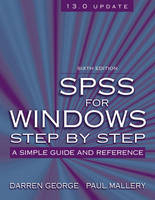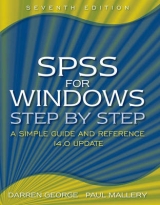
SPSS for Windows Step-by-Step
Routledge (Verlag)
978-0-205-48071-5 (ISBN)
- Titel erscheint in neuer Auflage
- Artikel merken
Are you confused by SPSS? Do you understand the concepts of statistics, but struggle with the computer analysis? Are you tired of figuring out in hours what should only take you minutes? Or are you just looking for a straightforward, comprehensive reference for SPSS? SPSS for Windows Step by Step: A Simple Guide and Reference 13.0 Update efficiently shows you how to perform the most common data analysis procedures in SPSS. It is brief but comprehensive. The first part of the book explains the basics of creating and formatting a data set, and includes a chapter on graphs that accommodate the changes in SPSS 13.0. Chapters 6-28 explain, step-by-step, the most common procedures in the Base System Module and the Advanced and Regression Modules. Each chapter is arranged in three parts: *"Introduction" explains the following procedure at the general, conceptual level, avoiding excessive detail and excessive emphasis on computation. *"Step by Step" boxes and screen shots break down each procedure with clear references to tasks covered in previous chapters. *"Outcome" explains the output of what you have just performed and defines critical terms.All data sets used in this book are available for download on the companion website: http://www.
ablongman.com/george6e, saving you the time of entering data.
1. An Overview of SPSS for Windows Step by Step
2. SPSS Windows Processes: Mouse and keyboard processing, frequently-used dialog boxes, editing output, printing results, the Options Option
3. Creating and Editing a Data File
4. Managing Data: Listing cases, replacing missing values, computing new variables, recoding variables, exploring data, selecting cases, sorting cases, merging files
5. GRAPHS: Creating and editing graphs and charts
BASE SYSTEM MODULE
6. FREQUENCIES: Frequencies, bar charts, histograms, percentiles
7. DESCRIPTIVE Statistics: Measures of central tendency, variability, deviation from normality, size, and stability
8. CROSSTABULATION and Chi-Square (*2) Analyses
9. The MEANS Procedure
10. Bivariate CORRELATION: Bivariate correlations, partial correlations, and the correlation matrix
11. The T TEST Procedure: Independent-samples, paired-samples, and one-sample tests
12. The One-Way ANOVA Procedure: One-way Analysis of Variance
13. General Linear Models: Two-Way Analysis of Variance
14. General Linear Models: Three-Way Analysis of Variance and the influence of covariates
15. Simple Linear REGRESSION
16. MULTIPLE REGRESSION ANALYSIS
17. NONPARAMETRIC Procedures
18. RELIABILITY ANALYSIS: Coefficient alpha (*) and split-half reliability
19. MULTIDIMENSIONAL SCALING
20. FACTOR ANALYSIS
21. CLUSTER ANALYSIS
22. DISCRIMINANT ANALYSIS
ADVANCED and REGRESSION MODULES
23. General Linear Models: MANOVA and MANCOVA Multivariate Analysis of Variance and Covariance
24. General Linear Models: Repeated-Measures MANOVA: Multivariate Analysis of Variance with repeated measures and within-subjects factors
25. LOGISTIC REGRESSION
26. Hierarchical LOGLINEAR MODELS
27. General LOGLINEAR MODELS
28. RESIDUALS: Analyzing left-over variance
Data Files
Glossary
References
Index
| Erscheint lt. Verlag | 21.10.2005 |
|---|---|
| Verlagsort | New York |
| Sprache | englisch |
| Maße | 276 x 217 mm |
| Gewicht | 880 g |
| Themenwelt | Mathematik / Informatik ► Mathematik ► Computerprogramme / Computeralgebra |
| ISBN-10 | 0-205-48071-3 / 0205480713 |
| ISBN-13 | 978-0-205-48071-5 / 9780205480715 |
| Zustand | Neuware |
| Haben Sie eine Frage zum Produkt? |
aus dem Bereich



